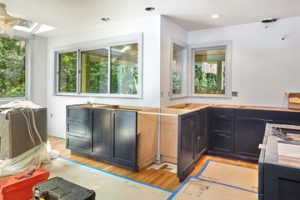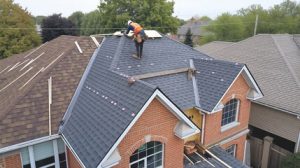Cabinet Refinishing Modesto offers a dramatic kitchen update without the hassle, expense, and environmental impact of a full renovation. Refinishing your cabinets is an excellent investment for homeowners who want to revamp their current kitchens.

Refinishing is a quicker process than a complete remodel. Proper care and maintenance will ensure your refinished cabinets look beautiful for years to come.
Cabinet refinishing gives your kitchen an instant upgrade without the cost and disruption of a full remodel. It also is environmentally friendly, reusing existing materials rather than sending them to the landfill. However, a successful cabinet refinishing project requires adequate preparation to ensure the paint adheres correctly and minimizes imperfections that may show up later in the transformation process.
Begin the prep stage by clearing all surfaces of your cabinets. This includes removing any hardware and appliances you wish to keep, as well as covering any areas of your room you don’t want painted. This helps protect surfaces and furnishings from accidental splatters and drips that could ruin their appearance. Masking also is beneficial to protect adjoining surfaces from being impacted by your project, including your countertops and walls. Painter’s tape is a great option, but masking paper and plastic film also can be used to achieve the same effect.
If you are going to refinish your cabinets, the next step is to lightly sand the surface to remove any sheen and prepare it for priming. Using an electric sander or by hand, sand the cabinets until you have a smooth and even finish. Be sure to sand the entire surface of your cabinets, including any areas that will be covered by cabinet hardware or hinges. After sanding, wipe down the cabinets with a damp cloth to remove any dust and residue.
Finally, prime the cabinets with a high-quality primer that is suitable for your cabinet material. After the primer dries, sand again with fine-grit sandpaper to smooth and prep the surface for painting. A quality primer will provide a solid base for your new coat of paint and improve adhesion, which is especially important in moisture-prone environments like the kitchen.
If you are refinishing your cabinets, you can also choose to re-stain the wood for a completely transformed look. Staining is a more labor-intensive process than painting, but can be a good choice if you prefer the warm, natural color of wood or want to make your cabinets look older and more rustic.
Cleaning
The cleaning of cabinets is one of the most important steps in cabinet refinishing. It removes dust, dirt, grime, oil and grease from the surface and prepares it for a new finish. Harsh chemicals and abrasive sponges or scrub pads should be avoided as they will damage the surface. Instead, a mild cleaning solution, such as Murphy Oil Soap or Orange Cleaner is recommended. For a more thorough cleaning, a non-scratch scrub brush can also be used.
A regular, routine cleaning of kitchen cabinets will help keep them looking new. Once or twice a week, a soft microfiber cloth dipped in warm water can be used to wipe down surfaces and grooves, making sure to get into corners and crevices where grease may hide. For a deeper cleaning, a mixture of water and safe, grease-cutting cleaner can be applied with a sponge or cloth. Some user forums recommend Krud Kutter as a good degreaser, while others prefer TSP (Trisodium Phosphate).
Once the cabinets are clean, it is often necessary to sand them. This will smooth the existing surface and create a better paint adhesion. Using medium-grit sandpaper is usually adequate. Once the sanding is complete, it is important to re-wipe with a damp cloth to remove any dust or residue that remains on the cabinet surface.
It is also important to wipe all surfaces, including cabinet hardware, with a clean damp cloth before starting the refinishing process. Any dirt or dust that is left on the hardware can scratch the surface and make it more difficult to work with.
Some users of this website have experienced problems with refinishing cabinet doors that have been painted with non-cabinet paint. The problem is that the paint tends to absorb grease, causing it to break down faster. While this is less of a problem with professionally painted cabinet projects, it can occur with DIY paint jobs that have been done over oak. The best way to test for grease absorption is to press a fingernail into the dark spot; if it leaves an imprint, the cabinet will need to be stripped and repainted.
Hardware
Cabinet hardware adds a finishing touch to your kitchen and can elevate the overall look of your cabinetry. When shopping for new hardware, it is important to consider the style and scale of each piece. To avoid creating a mismatched or chaotic appearance, it is best to keep your cabinet hardware styles separate in scale and finish. By pairing different types of knobs, pulls, and handles, you can create a more layered, curated, and designed aesthetic.
To maintain a beautiful appearance, it is essential to clean your cabinet hardware regularly. A simple wipe down with a damp cloth can remove dirt, grime, and food stains. For stubborn stains, you can use a gentle cleaner formulated for cabinets. Regular cleaning prevents your cabinets from becoming damaged or warped, which can happen when wood is exposed to changes in temperature or humidity.
Choosing the right knobs, handles, and pulls can be challenging, but with a little research you can find the perfect style for your kitchen. To begin, you should determine the desired style for your space and choose a color that complements your overall design. Then, narrow down your options by size, shape, and material to select the pieces that will make a difference in your home.
There are two main ways to update your kitchen cabinets: refacing and refinishing. Refacing involves replacing the existing doors and drawer fronts, which can cost a few thousand dollars to as much as $15,000. Refinishing is a less expensive option that doesn’t require any structural changes.
The process of refacing and refinishing can be completed by a professional, but it is also possible to do the work yourself. Regardless of which option you choose, it is crucial to prepare your cabinets properly for a successful renovation. By following these steps, you can achieve beautiful results that last for years to come.
Inspection
Cabinet refinishing is a cost-effective alternative to replacing your kitchen cabinets that will breathe new life into the space. With the proper care and maintenance, your refinished cabinets will provide you with years of beauty. Regular inspections should be conducted to identify any issues that need addressing. Inspecting your cabinets regularly will also help to protect the investment you’ve made in this home improvement project.
Aside from the obvious time savings, refinishing is also a more environmentally friendly choice compared to replacing your cabinets. Cabinet refinishing allows for the reuse of existing materials and avoids waste generation, as well as the transportation and manufacturing of new cabinets.
Cabinet refacing is a more extensive remodeling project than refinishing, which requires removing the doors, hinges and handles, as well as sanding down the surface of your cabinets. Refacing will also require you to purchase new hardware, which can add up in costs. Regardless of which option you choose, it’s important to have an experienced contractor to ensure the job is done properly and professionally.
Over time, painted cabinets can begin to chip. This is a common occurrence, especially in high-traffic areas of the home like the kitchen. The good news is that chipped paint can easily be repaired with a simple repainting.
Solid wood cabinet doors are susceptible to warping over time. This is due to natural changes in temperature and humidity that can cause the wood to expand or contract. This can cause the cabinet door to warp and create gaps. While this can be frustrating, it is a simple fix with the help of a professional refinishing company.
Cabinet refinishing involves the sanding and priming of your cabinetry, followed by an application of a fresh coat of stain or paint. This can transform your kitchen, giving it a modern look that will make your home stand out.
As with any renovation project, proper care and attention are essential for keeping your refinished cabinets looking their best. Regular cleaning with a soft cloth or sponge and mild soap should be used to remove any dirt or dust. The use of harsh cleaners is not recommended as they can damage your cabinets’ wooden surfaces. It is also important to inspect your cabinets on a regular basis, especially in high-traffic areas, to make sure they are still secure and functioning correctly.
